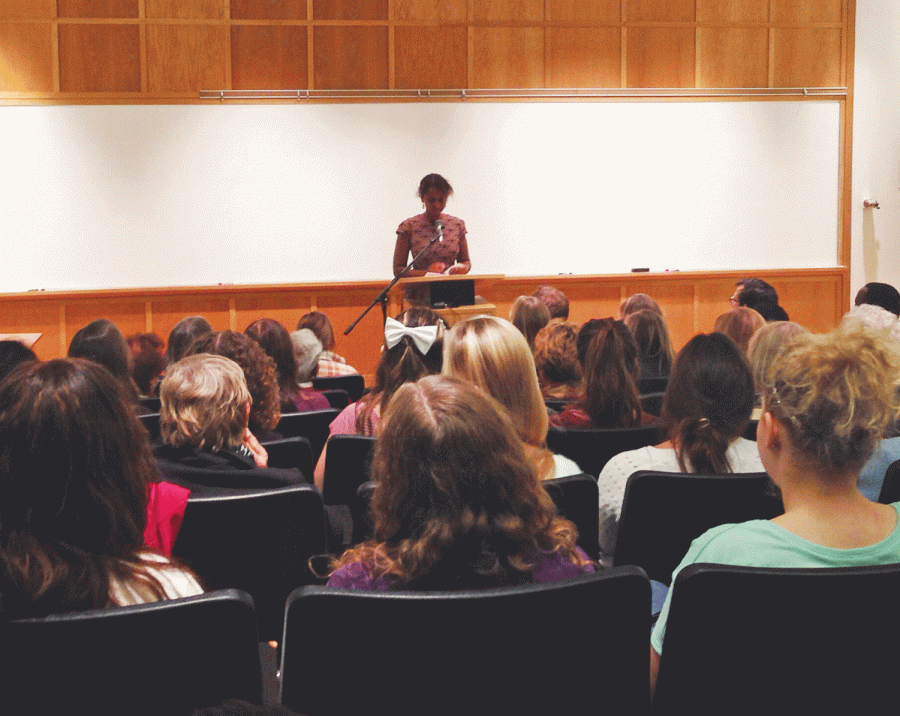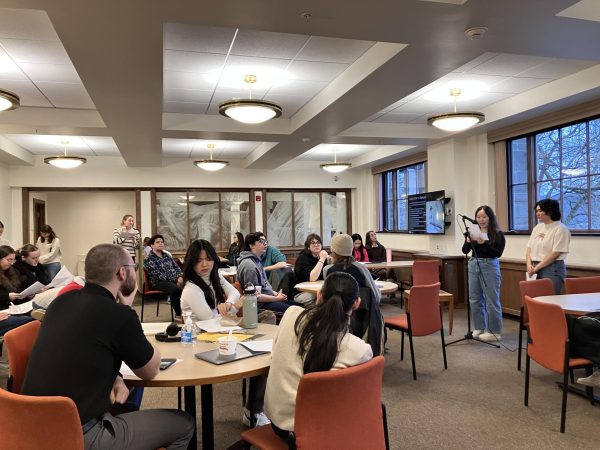Living Writers Series Brings Nadifa Mohamed to Campus
Through her luminous prose and intriguing dialogue, Nadifa Mohamed, the second author to make an appearance at this year’s Living Writers series, discussed writing and the Somali War last Thursday. Her most recent book, “The Orchard of Lost Souls,” examines the war through the lens of three women, ultimately asking readers to think about responses to violence.
Mohamed was born in Hargeisa, Somalia (now Somaliland) in 1981, but moved to London with her family in 1986 before the civil war broke out in Somalia. She studied history and politics at Oxford University before publishing her first novel “Black Mamba Boy” in 2009. The book, which chronicled her father’s life in Yemen, won the 2010 Betty Trask Award; it was shortlisted for the 2010 “Guardian” First Book Award, the 2010 Dylan Thomas Prize and the 2010 John Llewellyn Rhys Prize. It was also long-listed for the 2010 Orange Prize for Fiction. “The Orchard of Lost Souls,” Mohamed’s second novel was released in 2013 and led to her rightful place on the prestigious 2013 Granta “Best of Young British Novelists list.”
At the talk, Mohamed read three passages from her book, which is split up into various parts from the points of view of the three main characters: Deqo, Kawsar and Filsan. She explained how these three characters were based very loosely on people she knew, or people she wished that she had known.
Deqo, a young orphaned Somali girl, spends the novel roaming the streets and searching for a makeshift family. She was born at an orphanage to her mother who everyone tells her was a whore, although she does not know what that word means. Deqo describes her wish for a family, stating how even a second and third name would make her happy.
“When she was too young to know better she had taken the name Deqo Red Cross because that was the name of the clinic she lived in, but the frowns on the white-uniformed nurses’ faces let her know it wouldn’t do as a replacement name,” Mohamed said, reading from “The Orchard of Lost Souls.”
The second character, Kawsar, is an elderly woman who has been confined to her bed after a brutal police beating left her unable to walk. She describes the decaying of her own body and the failure of her organs, saying how only her heart seems to be surviving.
“She wishes she could give it a sugar cube and say, ‘Well done, you have served me well, but it’s time to retire now,’” read Mohamed.
Filsan, the third woman, is the one that Mohamed struggled with writing about the most, she told the audience. As a complicated woman in the army, Filsan has committed many questionable acts in her life. After approaching three village elders whom her commander said were assisting outlaws from the National Freedom Movement, one swings her cane at her. Filsan fires back with her gun, unaware of the damage that she is doing to these men.
“When the elder falls back onto his behind she assumes that he has lost his balance trying to strike her, until points of blood spring up over his shirt, turning the white cloth a red that darkens before her eyes,” Mohamed read from the text.She explained how some of the horrific acts of violence in her novel may have actually occurred in Somalia. In one scene, Filsan witnesses schoolchildren being drained like taps so that their blood could be used to help injured soldiers.
While Mohamed said it is difficult to prove that this actually occurred, she told the audience that people had found the bodies of 12 school children with their uniforms on, and all the evidence points to them being drained just like the children in Mohamed’s novel. However, rather than focus on the war itself, Mohamed chose to write her book about women. She explained how women have always had to deal with political issues, but what really strikes them, what really haunts their every move, is their personal heartaches.
“It is the insides that I’m interested in, rather than the physical aspects of the war.” Mohamed said.
Somali women are often referred to as victims, which is something that Mohamed does not find appropriate. She says that referring to them in that manner transforms them into two dimensional characters, or simply people to whom the rich should send money. However, Mohamed described how Somali women are strong people that were able to deal with the harsh trials and tribulations that encompassed their lives during wartime.
Ultimately, Mohamed is interested in how individuals form themselves. How do young children, especially those like Deqo who are entirely on their own, see the world around them? Mohamed explored questions like this one during her Living Writers talk, as well as throughout her novel.







